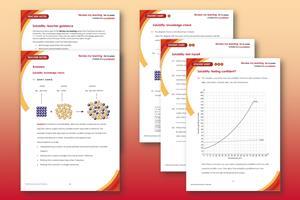Review your learners’ understanding of key ideas, words and phrases relating to solubility
This resource features three different versions of a worksheet on solubility: scaffolded, partially scaffolded and unscaffolded. Use the worksheets to identify learners’ knowledge gaps and misconceptions once you have taught this part of the curriculum. Find out more about how to use this resource or download the worksheets below.
-

Download this
Download the scaffolded, partially scaffolded and unscaffolded student worksheets.
You will find model answers in the teacher guidance.
View and download more Review my learning worksheets
Curriculum topics
These worksheets cover the following topics:
- terminology associated with solubility
- dilute and concentrated solutions
- measuring the concentration of solutions
- calculating masses of solute in a given volume of solution
- saturated solutions
- precipitate formation
- methods of separation based on solubilities.
If learners successfully answer questions on these topics, they can attempt the extension question. This requires learners to deduce information from solubility curves.
How to use this resource
The worksheets can be used in a variety of ways:
- to assess learners’ knowledge at the beginning or end of a period of teaching. Match the level of the worksheet to the support needs of the learners;
- to assess knowledge during a period of teaching once learners have completed the relevant topic;
- as part of revision;
- as a refresher exercise for teachers or non-subject specialists.
- as a refresher exercise for learners or teachers looking to check their own subject knowledge.
There is also scope for the level of the worksheets used to be increased as learners progress through their curriculum.
Scaffolding
Three levels of support, provide options depending on the diverse support needs of learners. An editable version of each worksheet provides further opportunities to adapt the resources to meet individual learning needs. There is also scope to increase the level of the worksheets used, as learners progress through their curriculum.
Independent learning and metacognition
The ‘What do I understand?’ page is common to all worksheets. Learners are encouraged to develop independent learning skills and can use their reflection as a guide for revision. The feedback will also help you to identify areas where a whole class needs attention.
Answers
The teacher guidance provides model answers for all questions, plus guidance on learners’ common misconceptions. Learners can use the model answers to peer or self-assess.
More resources
- Learn how to prepare a sample of pure, dry, hydrated copper sulfate crystals from copper oxide with the Preparing a soluble salt practical video and supporting resources.
- Explore the effect of temperature on solubility with this class experiment.
- Watch the video job profile and show learners how they can work and study through a degree apprenticeship, such as Holly who helped solve AstraZeneca’s drug compound solubility problem.
- Use the How to teach intermolecular forces at 14–16 CPD article’s tips and resources to clear up misconceptions and help learners understand molecules and the material and natural world around them.
Downloads
Solubility scaffolded student worksheet
Handout | PDF, Size 0.72 mbSolubility partially scaffolded student worksheet
Handout | PDF, Size 0.54 mbSolubility unscaffolded student worksheet
Handout | PDF, Size 0.69 mbSolubility teacher guidance and answers
Handout | PDF, Size 0.36 mbSolubility scaffolded student worksheet
Editable handout | Word, Size 0.47 mbSolubility partially scaffolded student worksheet
Editable handout | Word, Size 0.45 mbSolubility unscaffolded student worksheet
Editable handout | Word, Size 0.47 mbSolubility teacher guidance and answers
Editable handout | Word, Size 0.26 mb












No comments yet